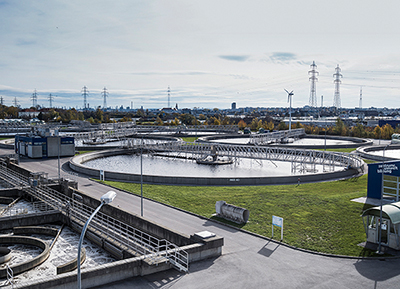Siemens helps transform the main wastewater treatment plant in Vienna into a green power plant

Siemens will support the city of Vienna in optimizing its main sewage plant in terms of energy. For this purpose, Siemens is supplying the control, measuring, analytical and power distribution systems, as well as the low-voltage and medium-voltage switchgear.
Furthermore, the order includes the installation and commissioning of the individual systems. The order is worth around 24 million euros and is part of “E_OS 2020” (Energy_Optimization Sludge Treatment), the largest environmental project ever undertaken by the city of Vienna.
As from 2020, the main sewage plant will use sewage gas to generate autonomously all the energy required for the wastewater treatment. For the sewage treatment itself, a particularly efficient method is used with reduced water content and double the solid content. This considerably reduces the energy consumed during anaerobic digestion and gas generation.
The main sewage plant, which currently is among the largest energy consumers in the community, should generate an output of 78 GWh of electricity and 82 GWh of thermal energy. In total this method should save about 40,000 metric tons of CO2 per year.
Christian Gantner, Director General of the ebswien main sewage plant: “Our conversion of the wastewater treatment plant into a green power plant makes a valuable contribution to both a responsible use of natural resources and to sustainable power generation. The efficient technologies of our partner Siemens play a key role in achieving our ambitious environmental and climate targets.”
Wolfgang Hesoun, Chief Executive Officer of Siemens AG Austria: “An essential factor of success for achieving the environmental targets of a city are the measures that generate maximum ecological and economic benefit. On the basis of extensive analyses we have managed, together with our customer, to develop a tailor-made solution that will help the largest environmental project ever undertaken by the city of Vienna to become a success. In doing so, we are focusing as much on energy efficiency, preservation of resources and sustainability as we are on smart technologies and networked systems.”
The order includes the migration and expansion of the existing Simatic PCS 7 process control system to the latest Version 8.1. The conversion work is taking place in parallel with normal operations. All functions are tested already in the engineering phase with the Simit simulation software, enabling quality to be assured and commissioning times to be shortened. In addition, Siemens is supplying Sitrans process instrumentation, devices for gas analysis (Ultramat/Oximat), as well as Scalance network components, including cabling, installation and commissioning. For a safe, high-availability power supply to about 450 motors and drives in the sewage plant, Siemens is installing a redundant 20 kV medium-voltage power distribution system of the type NXAir (28 fields), Sivacon S8 low-voltage power distribution systems (about 80 fields), a busbar trunking system, and 14 transformers. The protection devices of the existing systems and those of the new systems are equipped by Siemens with Ethernet-based communication interfaces. The redundant SICAM AK 3 station control technology processes all data points from the energy supply and delivers these to the higher-level switchgear control technology and subsequently for the overall monitoring of the new process control system.
For further information, please see www.siemens.com/water
Siemens AG (Berlin and Munich) is a global technology powerhouse that has stood for engineering excellence, innovation, quality, reliability and internationality for more than 165 years. The company is active in more than 200 countries, focusing on the areas of electrification, automation and digitalization. One of the world's largest producers of energy-efficient, resource-saving technologies, Siemens is No. 1 in offshore wind turbine construction, a leading supplier of gas and steam turbines for power generation, a major provider of power transmission solutions and a pioneer in infrastructure solutions as well as automation, drive and software solutions for industry. The company is also a leading provider of medical imaging equipment – such as computed tomography and magnetic resonance imaging systems – and a leader in laboratory diagnostics as well as clinical IT. In fiscal 2015, which ended on September 30, 2015, Siemens generated revenue of €75.6 billion and net income of €7.4 billion. At the end of September 2015, the company had around 348,000 employees worldwide.
Further information is available on the Internet at www.siemens.com
Reference Number: PR2015110045PDEN
Contact
Mr. David Petry
Process Industries and Drives Division
Siemens AG
Schuhstr. 60
91052 Erlangen
Germany
Tel: +49 (9131) 7-26616
david.petry@siemens.com
Mr. Heiko Jahr
Energy Management Division
Siemens AG
Freyeslebenstr. 1
91058 Erlangen
Germany
Tel: +49 (9131) 7-29575
heiko.jahr@siemens.com
Media Contact
All latest news from the category: Power and Electrical Engineering
This topic covers issues related to energy generation, conversion, transportation and consumption and how the industry is addressing the challenge of energy efficiency in general.
innovations-report provides in-depth and informative reports and articles on subjects ranging from wind energy, fuel cell technology, solar energy, geothermal energy, petroleum, gas, nuclear engineering, alternative energy and energy efficiency to fusion, hydrogen and superconductor technologies.
Newest articles

NASA: Mystery of life’s handedness deepens
The mystery of why life uses molecules with specific orientations has deepened with a NASA-funded discovery that RNA — a key molecule thought to have potentially held the instructions for…

What are the effects of historic lithium mining on water quality?
Study reveals low levels of common contaminants but high levels of other elements in waters associated with an abandoned lithium mine. Lithium ore and mining waste from a historic lithium…

Quantum-inspired design boosts efficiency of heat-to-electricity conversion
Rice engineers take unconventional route to improving thermophotovoltaic systems. Researchers at Rice University have found a new way to improve a key element of thermophotovoltaic (TPV) systems, which convert heat…



